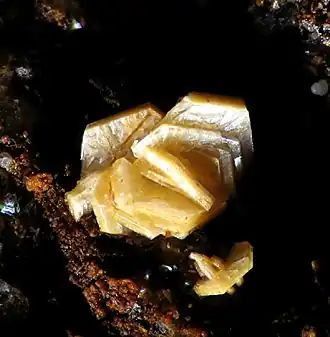Synchysite
| Synchysite | |
|---|---|
 A synchysite with unknown end-member composition | |
| General | |
| Category | Minerals |
| Formula | Ca(REE)(CO3)2F |
| Strunz classification | 5.BD. |
| Crystal system | Monoclinic and trigonal |
| Space group | C2/c (monoclinic) |
| Identification | |
| Mohs scale hardness | 4.5 |
| References | [1][2] |
Synchysite is a group of carbonate minerals.[3] The three isostructural chemical end members are synchysite-(Ce), synchysite-(Nd) and synchysite-(Y). Huanghoite-(Ce) belongs to the group, but has a different symmetry and calcium is replaced by barium.[4][5]
| Mineral name | Chemical formula | Symmetry | Space group |
|---|---|---|---|
| Huanghoite-(Ce) | BaCe(CO 3) 2F |
||
| Synchysite-(Ce) | Ca(Ce,La)(CO 3) 2F |
||
| Synchysite-(Nd) | CaNd(CO 3) 2F |
||
| Synchysite-(Y) | CaY(CO 3) 2F |
References
- ^ "Synchysite-(Ce)" (PDF). handbookofmineralogy. Retrieved 24 February 2013.
- ^ Wang, L.; Ni, Y.; Hughes, J.M.; Bayliss, P.; Drexler, J.W. (1994). "The atomic arrangement of synchysite-(Ce), CeCaF(CO3)2". The Canadian Mineralogist. 32: 865–871. Retrieved 30 December 2020.
- ^ "Synchysite Group". Retrieved 24 February 2013.
- ^ "Synchysite-(Ce)". Retrieved 24 February 2013.
- ^ "Huanghoite-(Ce)". Retrieved 24 February 2013.